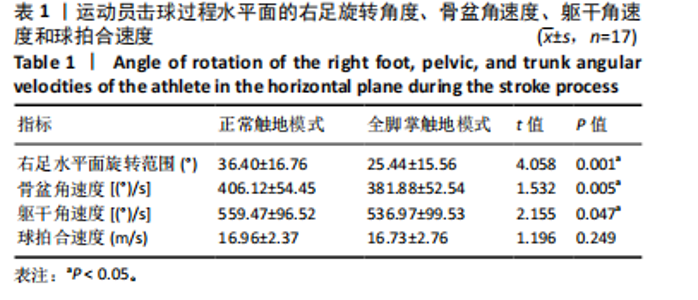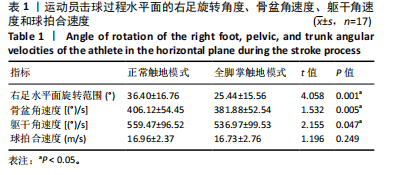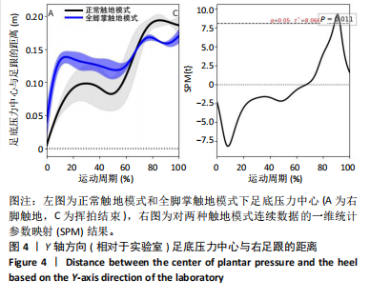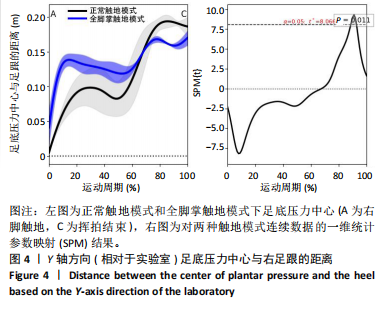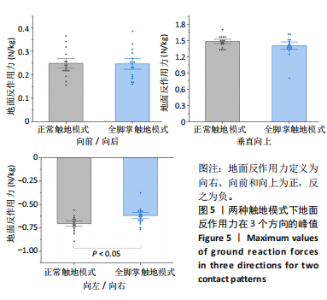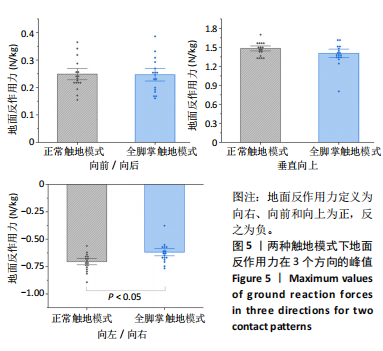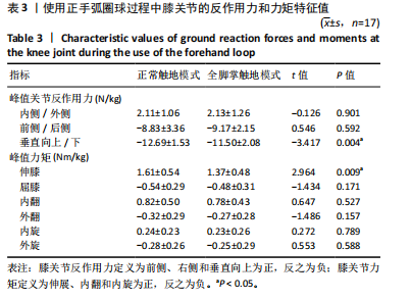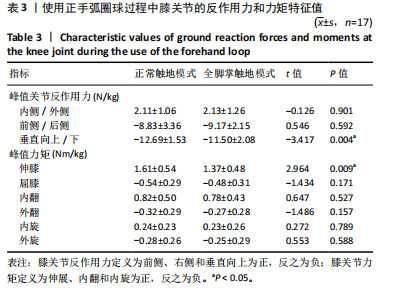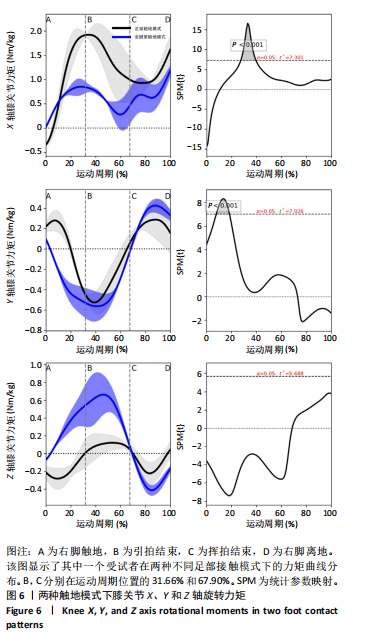Chinese Journal of Tissue Engineering Research ›› 2025, Vol. 29 ›› Issue (14): 2995-3001.doi: 10.12307/2025.607
Previous Articles Next Articles
Biomechanical changes of the lower limbs in table tennis players with different foot contact patterns of table tennis forehand loop
Jin Pengfei, Ren Jie
- China Table Tennis College, Shanghai University of Sport, Shanghai 200438, China
-
Received:2024-05-06Accepted:2024-06-26Online:2025-05-18Published:2024-09-29 -
Contact:Ren Jie, PhD, Professor, China Table Tennis College, Shanghai University of Sport, Shanghai 200438, China -
About author:Jin Pengfei, Master candidate, China Table Tennis College, Shanghai University of Sport, Shanghai 200438, China -
Supported by:a grant from Science and Technology Commission of Shanghai Municipality, No. 22010503700 (to RJ)
CLC Number:
Cite this article
Jin Pengfei, Ren Jie. Biomechanical changes of the lower limbs in table tennis players with different foot contact patterns of table tennis forehand loop[J]. Chinese Journal of Tissue Engineering Research, 2025, 29(14): 2995-3001.
share this article
Add to citation manager EndNote|Reference Manager|ProCite|BibTeX|RefWorks
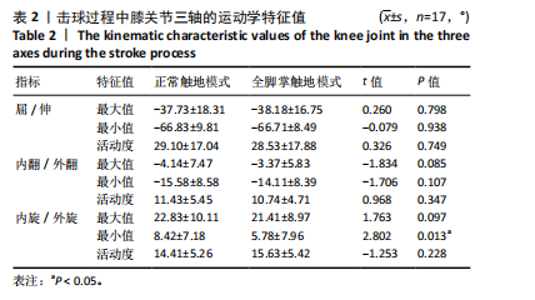
P=0.001)。在正常触地模式下,髋关节(t=1.532,P=0.005)和躯干(t=2.155,P=0.047)水平面旋转角速度显著大于全脚掌触地模式,但挥拍合速度并不存在显著性差异。这可能是正常触地模式下,击球力量是从下肢向上传递,右足能够通过更大的旋转范围,使半屈位下肢关节完成更大范围且更快速的伸展功能,为躯干和髋提高角速度提供了重要条件。而全脚掌触地模式可能是通过手臂加速,以此代偿下肢传递的力量不足。 2.3 击球过程中膝关节运动学特征 膝关节的运动学特征如表2所示,正常触地模式下膝关节内旋角度最小值显著高于全脚掌触地模式(t=2.802,P=0.013)。但膝关节在其他方向的运动并不存在显著性差异,这可能是膝关节角度的稳定性是运动员控制重心、保证击球效果的一个重要因素。"
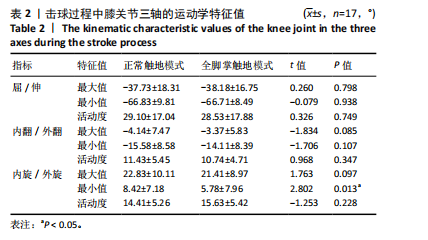
| [1] IINO Y, KOJIMA T. Kinetics of the upper limb during table tennis topspin forehands in advanced and intermediate players. Sports Biomech. 2011; 10(4):361-377. [2] YANG X, HE Y, SHAO S, et al. Gender Differences in Kinematic Analysis of the Lower Limbs during the Chasse Step in Table Tennis Athletes. Healthcare (Basel). 2021;9(6):703. [3] LE MANSEC Y, DOREL S, HUG F, et al. Lower limb muscle activity during table tennis strokes. Sports Biomech. 2018;17(4):442-452. [4] IINO Y, KOJIMA T. Kinematics of table tennis topspin forehands: effects of performance level and ball spin. J Sports Sci. 2009;27(12):1311-1321. [5] BEDO BLS, CATELLI DS, LAMONTAGNE M, et al. Fatigue modifies hip and knee kinematics during single- and double-leg dynamic tasks: An investigation with female handball players. J Sports Sci. 2022;40(17):1964-1972. [6] YANG X, MEI Q, SHAO S, et al. Understanding Sex-Based Kinematic and Kinetic Differences of Chasse-Step in Elite Table Tennis Athletes. Bioengineering (Basel). 2022;9(6):246. [7] LIN JZ, CHIU WY, TAI WH, et al. Ankle Muscle Activations during Different Foot-Strike Patterns in Running. Sensors (Basel). 2021;21(10):3422. [8] AHN AN, BRAYTON C, BHATIA T, et al. Muscle activity and kinematics of forefoot and rearfoot strike runners. J Sport Health Sci. 2014;3:102-112. [9] LI X. Biomechanical Analysis of Different Footwork Foot Movements in Table Tennis. Comput Intell Neurosci. 2022;2022:9684535. [10] HE Y, SUN D, YANG X, et al. Lower limb kinetic comparisons between the chasse step and one step footwork during stroke play in table tennis. PeerJ. 2021;9:e12481. [11] LAM WK, FAN JX, ZHENG Y, et al. Joint and plantar loading in table tennis topspin forehand with different footwork. Eur J Sport Sci. 2019;19(4):471-479. [12] YU C, SHAO S, BAKER JS, et al. Comparing the biomechanical characteristics between squat and standing serves in female table tennis athletes. PeerJ. 2018;6:e4760. [13] 任元师.乒乓球运动员疲劳后踝、膝关节损伤风险研究[D]. 上海:上海体育学院,2022. [14] RICHARDS DP, AJEMIAN SV, WILEY JP, et al. Relation between ankle joint dynamics and patellar tendinopathy in elite volleyball players. Clin J Sport Med. 2002;12(5):266-272. [15] LIU X, IMAI K, ZHOU X, et al. Influence of Ankle Injury on Subsequent Ankle, Knee, and Shoulder Injuries in Competitive Badminton Players Younger Than 13 Years. Orthop J Sports Med. 2022;10(5):23259671221097438. [16] WARMENHOVEN J, HARRISON A, ROBINSON MA, et al. A force profile analysis comparison between functional data analysis, statistical parametric mapping and statistical non-parametric mapping in on-water single sculling. J Sci Med Sport. 2018;21(10):1100-1105. [17] ADLER RJ, TAYLOR JE. Random Fields and Geometry. New York, NY: Springer New York, 2007. [18] YONG JR, DEMBIA CL, SILDER A, et al. Foot strike pattern during running alters muscle-tendon dynamics of the gastrocnemius and the soleus. Sci Rep. 2020;10(1):5872. [19] FU F, ZHANG Y, SHAO S, et al. Comparison of center of pressure trajectory characteristics in table tennis during topspin forehand loop between superior and intermediate players. Int J Sports Sci Coa. 2016;11(4):559-565. [20] HE Y, FEKETE G, SUN D, et al. Lower Limb Biomechanics during the Topspin Forehand in Table Tennis: A Systemic Review. Bioengineering (Basel). 2022; 9(8):336. [21] CHU SK, JAYABALAN P, KIBLER WB, et al. The Kinetic Chain Revisited: New Concepts on Throwing Mechanics and Injury. PM R. 2016;8(3 Suppl):S69-77. [22] KIBLER WB. Closed kinetic chain rehabilitation for sports injuries. Phys Med Rehabil Clin N Am. 2000;11(2):369-384. [23] KOTSIFAKI A, KORAKAKIS V, GRAHAM-SMITH P, et al. Vertical and Horizontal Hop Performance: Contributions of the Hip, Knee, and Ankle. Sports Health. 2021;13(2):128-135. [24] HAMILL J, GRUBER AH, DERRICK TR. Lower extremity joint stiffness characteristics during running with different footfall patterns. Eur J Sport Sci. 2014;14(2):130-136. [25] DUMKE CL, PFAFFENROTH CM, MCBRIDE JM, et al. Relationship between muscle strength, power and stiffness and running economy in trained male runners. Int J Sports Physiol Perform. 2010;5(2):249-261. [26] RAMÍREZ-DELACRUZ M, BRAVO-SÁNCHEZ A, ESTEBAN-GARCÍA P, et al. Effects of Plyometric Training on Lower Body Muscle Architecture, Tendon Structure, Stiffness and Physical Performance: A Systematic Review and Meta-analysis. Sports Med Open. 2022;8(1):40. [27] 张希妮,邓力勤,肖松林,等.不同跑步着地习惯对跟腱形态学及其负荷特征的影响[J].医用生物力学,2024,39(1):132-138. [28] KOZINC Ž, SMAJLA D, ŠARABON N. The relationship between lower limb maximal and explosive strength and change of direction ability: Comparison of basketball and tennis players, and long-distance runners. PLoS One. 2021;16(8):e0256347. [29] SMAJLA D, KOZINC Ž, ŠARABON N. Associations between lower limb eccentric muscle capability and change of direction speed in basketball and tennis players. PeerJ. 2022;10:e13439. [30] DE SWART AFMJ, VAN TRIGT B, WASSERBERGER K, et al. Energy flow through the lower extremities in high school baseball pitching. Sports Biomech. 2022:1-15. doi: 10.1080/14763141.2022.2129430. [31] PRYHODA MK, SABICK MB. Lower body energy generation, absorption, and transfer in youth baseball pitchers. Front Sports Act Living. 2022;4:975107. [32] QIAN J, ZHANG Y, BAKER JS, et al. Effects of performance level on lower limb kinematics during table tennis forehand loop. Acta Bioeng Biomech. 2016;18(3):149-155. |
| [1] | Liu Mengling, Li Yongjie, Liu Hongju. Effect of increased stride length on knee kinematics and dynamics of asymmetric gait after anterior cruciate ligament reconstruction [J]. Chinese Journal of Tissue Engineering Research, 2025, 29(33): 7109-7115. |
| [2] | Gao Yuan, Xiong Zheyu, Zheng Wei, Chen Haonan, Chen Fangyuqing. Lower extremity biomechanical characterization during step-down test in patients with patellofemoral pain [J]. Chinese Journal of Tissue Engineering Research, 2025, 29(32): 6913-6919. |
| [3] | Guo Ping, Wang Juan. Bilateral lower limb biomechanical abnormalities in patients with unilateral chronic ankle instability [J]. Chinese Journal of Tissue Engineering Research, 2025, 29(32): 6920-6926. |
| [4] | Gou Yanyun, Hou Meijin, Jiang Zheng, Chen Shaoqing, Chen Xiang, Gao Yuzhan, Wang Xiangbin. Biomechanical characteristics of walking in patients with idiopathic scoliosis: cross-sectional analysis of three-dimensional motion capture [J]. Chinese Journal of Tissue Engineering Research, 2025, 29(3): 471-477. |
| [5] | Wang Zilong, Meng Xin, Zhang Zhiqi, Xie Yu, Meng Lingyue, Zhang Qiuxia, Kong Lingyu. Biomechanical characteristics of lower extremities during counter movement jump in male patients with functional ankle instability [J]. Chinese Journal of Tissue Engineering Research, 2025, 29(3): 478-485. |
| [6] | Dong Youqing, Wei Zixuan, Wu Haiou, Chen Ruixiong, Duan Peng, Chen Nan, Lin Xikai. Biomechanical characteristics of lower limbs in female patients with different types of patellofemoral pain syndrome [J]. Chinese Journal of Tissue Engineering Research, 2025, 29(21): 4458-4468. |
| [7] | Zhang Sizhuo, Liu Xiaoqian, Wang Guanglan. Effects of visual interference on biomechanical characteristics of lower limbs in athletes after anterior cruciate ligament reconstruction [J]. Chinese Journal of Tissue Engineering Research, 2025, 29(20): 4223-4229. |
| [8] | Wu Jing, Yao Yingce, Yang Xiaowei, Xue Boshi, Zhao Jianbin, Yang Chen, Luan Tianfeng, Zhou Zhipeng. Intervention of muscle strength training combined with neuromuscular electrical stimulation on lower limb function and biomechanical changes in patients with patellofemoral pain [J]. Chinese Journal of Tissue Engineering Research, 2024, 28(9): 1365-1371. |
| [9] | You Jing, Huang Wenqi, Zheng Wei, Lu Jieming, Guo Yanhua, Gao Yuan, Xiong Zheyu. Effects of kinesio taping on the biomechanical characteristics of the lower limbs during side-step cutting [J]. Chinese Journal of Tissue Engineering Research, 2024, 28(27): 4383-4389. |
| [10] | Wang Ke, Zhang Zeyi, Zhang Liwen, Zhang Meizhen. Biomechanics characteristics during sitting up in knee osteoarthritis patients of different ages: a systematic review and meta-analysis [J]. Chinese Journal of Tissue Engineering Research, 2024, 28(18): 2939-2946. |
| [11] | Bi Gengchao, Zhang Yanlong, Li Qiuyue, Hu Longwei, Zhang Yu. Knee joint mechanics and activation characteristics of surrounding muscles during deep jumps at different heights and distances [J]. Chinese Journal of Tissue Engineering Research, 2023, 27(8): 1211-1218. |
| [12] | You Guopeng, Wang Jianqing, Liu Fei, Yuan Qiang, Liu Haoyan, Wu Ying. Screening key technical indicators for speed climbing based on machine learning [J]. Chinese Journal of Tissue Engineering Research, 2023, 27(5): 738-744. |
| [13] | Liu Chang, Liu Lei, Ma Chaoqun, Cao Chuanxu, Xu Changzhi. Influencing factors and current situation of parametric design of knee prosthesis [J]. Chinese Journal of Tissue Engineering Research, 2023, 27(22): 3587-3593. |
| [14] | Yang Chen, Feng Ru, Zhou Zhipeng, Wan Xianglin, Qu Feng. Effects of knee sleeve on perceived pain and lower extremity kinematics and kinetics in male and female runners with patellofemoral pain [J]. Chinese Journal of Tissue Engineering Research, 2022, 26(17): 2749-2755. |
| [15] | Ouyang Yiyi, Peng Jie, Wang Kun, Zhang Tingran, Luo Jiong. Changes in biomechanical characteristics of children’s lower limbs during visual deprivation and dual tasks [J]. Chinese Journal of Tissue Engineering Research, 2022, 26(12): 1834-1842. |
| Viewed | ||||||
|
Full text |
|
|||||
|
Abstract |
|
|||||
